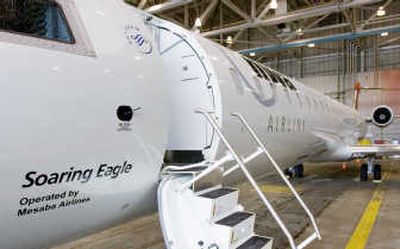Airlines spruce up regional flights

MINNEAPOLIS — Airlines are rushing to add new regional jets with first-class seats, roomier cabins and, in some cases, hot food.
The carriers are hoping business travelers tired of a cramped 50-seat jet will pay extra for a flight experience closer to what they get on a mainline jet. The addition could help airlines turn a profit on flights that have generally been a loss-leader feeding traffic into long-haul flights, although rising fuel prices could complicate the plan.
Airlines that recently went through bankruptcy — Northwest, Delta, and United — are the freest to add such jets because of relaxed restrictions in their pilot contracts.
Northwest Airlines Corp. is adding 72 new 76-seat jets through next year. Half will be Bombardier CRJ-900s flown by its Mesaba subsidiary and the other half will be Embraer 175s flown by its new Compass subsidiary. Both include a dozen first-class seats, and the cabin is roomier than on Northwest’s other regional jets. Delta Air Lines Inc. plans to fly 77 dual-class regional jets by the end of 2008, and United regional partners now fly about 115 70-seat jets with coach, first-class and an Economy Plus seat with extra legroom.
Delta spokeswoman Betsy Talton said business customers have been asking for the regional first-class seats for years. The aim with the new jets is “to make it all more seamless and more like the mainline jet experience,” she said.
First-class seats on Northwest’s new jets will include the same level of meal service as on regular flights. Northwest said it helped design its version of the Bombardier CRJ900, which has 6 feet 2 inches from floor to ceiling in the aisle, and windows that are 25 percent bigger than an earlier version of the CRJ900.
That’s a big improvement over the 50-seaters often used on regional routes, even if doesn’t quite match mainline flying, said aviation consultant George Hamlin of Airline Capital Associates Inc.
“You had to be a midget to see out the windows of the 50-seater, it was so low,” he said.
Brad Ness has flown United-affiliated smaller jets from Fargo, N.D., to Denver several times. “They certainly work,” said Ness, who is president of S&S Promotional Group in Fargo. “But the bigger ones would be nicer.”
Don Morton, who runs Microsoft’s campus in Fargo, flew first class on one of Northwest’s new jets recently. But he said that was only because the cost was competitive with offerings from other airlines. United and Delta feeders both fly to Fargo, too.
“It’s nice if it’s there,” he said of the first-class seats, “but if it’s not, somebody’s not going to not take Northwest.”
With regional jets covering longer distances, passengers are spending two hours or more on board those planes — making a first-class seat more desirable.
“As other carriers like Northwest and Delta and United roll out regional equipment that offers two-class configurations, that will turn out to be a competitive advantage for them,” said Darin Lee, senior managing economist at aviation consultancy LECG in Cambridge, Mass.
Using 76-seat jets on routes that had been flown by 50-seaters can turn around an unprofitable route, said aviation consultant Doug Abbey of The Velocity Group in Washington. For instance, passengers on Northwest’s regional jet flight between Fargo and Minneapolis pay $303 to go round trip in coach, but $981 to fly first class. Generally, many regional routes have lost money on their own but make money for the airline by feeding passengers into their hubs.
With high oil prices, even the new 76-seat jets are only a little better, said aviation consultant John F. Walsh of Walsh Aviation in Annapolis, Md. He said that while fuel might account for around a quarter of the cost of flying a mainline jet, it can be as much as 40 percent of the cost of flying a regional jet. That’s because the fuel cost is spread among fewer passengers, and the gas-guzzling takeoff is a larger proportion of the shorter flight.
Still, he said the new 76-seat jets make some sense for Northwest, especially compared with one jet it replaces — Northwest’s old 69-seat Avros. Northwest retired the four-engine gas hog from its regional fleet as it reorganized in bankruptcy.
The new regional jets improve margins by about 16 percentage points versus Northwest’s older 100-seat DC-9s, which they are replacing on some routes, Chief Financial Officer Dave Davis told analysts at a conference in June.